Kehinde Wiley, After Memling’s Portrait of Jacob Obrecht, 2013. Modern & Contemporary Art Day Sale, Afternoon Session.
One of the best ways for a student artist to learn is by copying the great works of their forbears. This of course applies to the young artists seen in museums with sketchbooks, but it is just as common for budding musicians to study how to harmonize melodies in the style of J. S. Bach, or for developing writers to learn to frame their ideas within the structure of Shakespeare’s tragedies. But when great contemporary artists engage with the masterworks of the past, their works goes beyond rote copying and instead can simultaneously pay homage to this lineage while calling attention to historic injustices. In a sense, their works can “repaint” art history and make a new case for representation, equity, and more.
Furthermore, when the historical works artists engage with are so pervasive as to have entered the vernacular of visual culture, the resonance of these new images can ring even louder. Here, we look to works by artists who seize the past in this way, each on offer in our upcoming Day Sale of Modern & Contemporary Art in New York on 15 May.
Kehinde Wiley
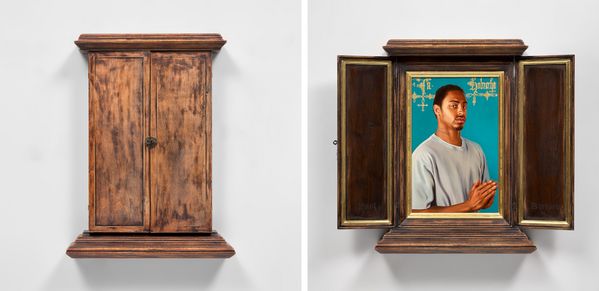
Kehinde Wiley, After Memling’s Portrait of Jacob Obrecht, 2013. Closed (left) and opened (right). Modern & Contemporary Art Day Sale, Afternoon Session.
Kehinde Wiley’s After Memling’s Portrait of Jacob Obrecht revisits a crucial moment in art history when artists began to produce portraits of the rising merchant class, which we can consider as the equivalent of today’s upper middle class. Before this time, portraiture was primarily reserved for nobility and clergy. In this work, Wiley replaces Memling’s original sitter — Jacob Obrecht, a prominent musician of the day — with the portrait of a contemporary young Black man. Unlike in Memling’s portrait, Wiley’s named sitter — Paul Bueford — meets us eye-to-eye, powerfully returning our gaze and seeming to demand we acknowledge his presence.
In this context, what we’re left to grapple with both looks to the past and to our present day. By correcting the absence of Black representation in this moment of art history, Wiley skillfully elevates contemporary Black figures to the level of significance that is culturally associated with Old Master portraiture. But also, by cleverly looking back to the moment in history that the upper middle class was rising, Wiley engages with issues that ring true between social classes today.
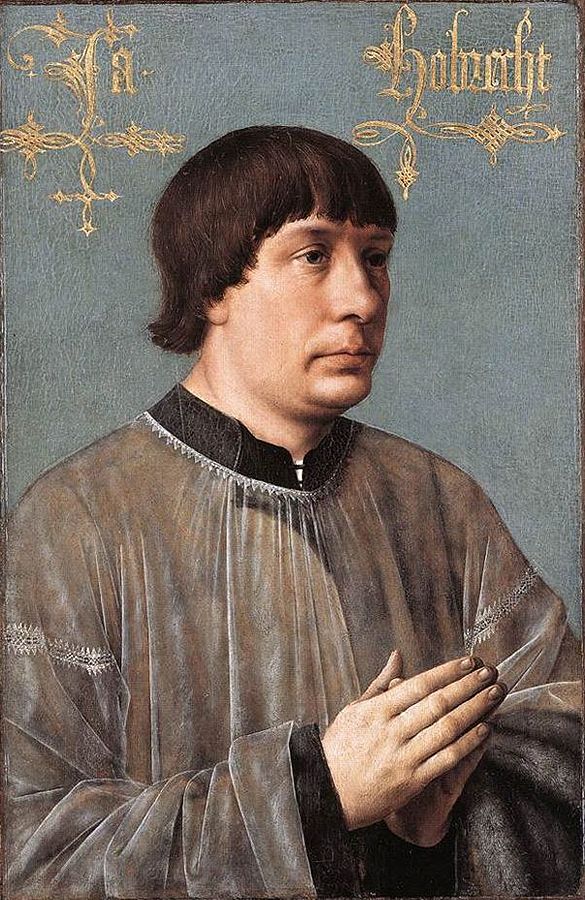
Hans Memling, Portrait of Jacob Obrecht, 1496. Kimbell Art Museum, Fort Worth, Texas.
Though it wrestles with charged historical and contemporary issues, After Memling’s Portrait of Jacob Obrecht is inviting and stunningly beautiful, constructed with an artist-crafted wooden frame that opens to reveal both the portrait and 22K gold leaf gilding. Executed at a rare and intimate scale for Wiley, it is one of only eight works from his Memling series and the first to appear at auction. Its presence in a Modern & Contemporary Art Sale at Phillips is also exciting, as Phillips set the world auction record for the artist just this past March in London.
Julie Curtiss

Julie Curtiss, D’après l’Origine du monde, 2016. Modern & Contemporary Art Day Sale, Afternoon Session.
In D’après l’Origine du monde, Julie Curtiss — a French artist raised in Paris — untangles the presence of the male gaze in Gustave Courbet’s iconic 1866 painting L’Origine du monde. Part of a body of work by Curtiss that confronts famed 19th century French paintings by artists including Georges Seurat and Édouard Manet, this work’s uncanny imagery invites viewers to unpack the conception of femininity across a wide timeline. This engagement with the past is surreal, incorporating the artist’s signature braided hair motif in a psychological confrontation with artists of a male-centric cultural lineage who can be considered as Curtiss’ forefathers.
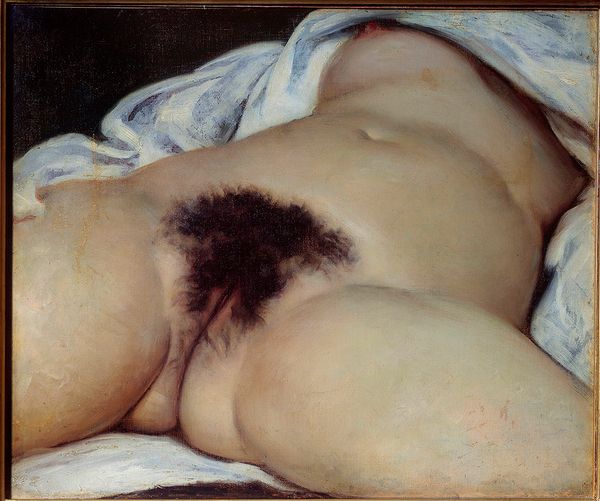
Gustave Courbet, L’Origine du monde, 1866, Musée d'Orsay, Paris, France. Image: Photo Josse/Scala, Florence.
By covering the entire body of the nude figure in hair, Curtiss invites viewers to consider the locations of a woman’s body where hair is viewed as beautiful and ladylike within the context of the 19th century male gaze. But she also strips that gaze of its cultural power. If female body hair is considered a rejection of traditional gender norms, Curtiss’ figure discards these norms with fantastical fervor. Staying true to the composition of Courbet’s painting, Curtiss evokes the contours of the original image in viewers minds, but cleverly challenges our memory of the work, demanding we grapple with complex issues while simultaneously deriding an oppressive visual lineage.
Titus Kaphar
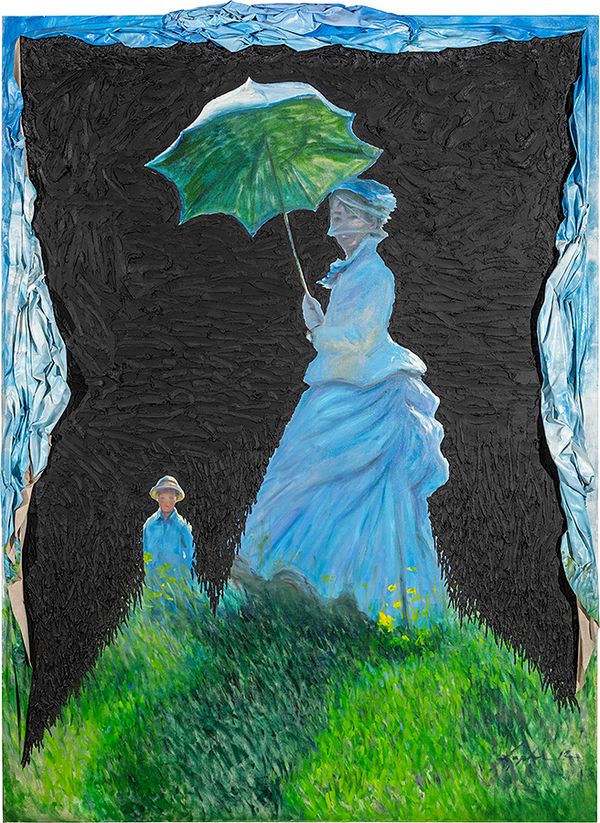
Titus Kaphar, Pushing Back the Light, 2012. Modern & Contemporary Art Day Sale, Afternoon Session.
For Titus Kaphar, a reverence for Impressionist painting goes hand-in-hand with his understanding of what these works ignore — the prevailing racial violence and injustice occurring when these works were created. In his poignantly titled work, Pushing Back the Light, he revisits Claude Monet’s 1875 painting Woman with a Parasol – Madame Monet and Her Son, literally pushing back the physical canvas to reveal black tar. This act draws attention to the artist’s physical labor and weaves a complex web of metaphors — Kaphar directly shows us the unseen darkness that lurks in the background of Impressionist works.
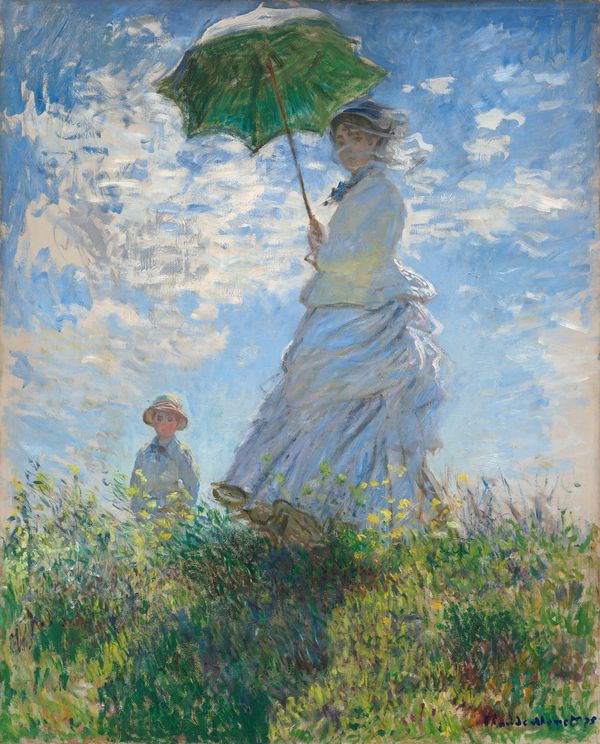
Claude Monet, Woman with a Parasol – Madame Monet and Her Son, 1875, National Gallery of Art, Washington, D.C. Image: © National Gallery of Art, Washington, D.C., Collection of Mr. and Mrs. Paul Mellon, 1983.1.29.
Pushing Back the Light was exhibited in the Phillips Collection’s 2020 exhibition Riffs and Relations, which highlighted Modern and Contemporary Black American artists who have engaged with, redefined, and interrogated European Modernism. “We look at these Impressionist paintings as beautiful pictures of the world, and to a degree they are,” the artist explains, going on to echo the terrors of segregation and European Colonialism in Africa that prevailed when Monet’s work was created: “While we are talking and thinking about color in this different kind of way, there are people on the other side of the world who are suffering because of their color.”
Ernie Barnes
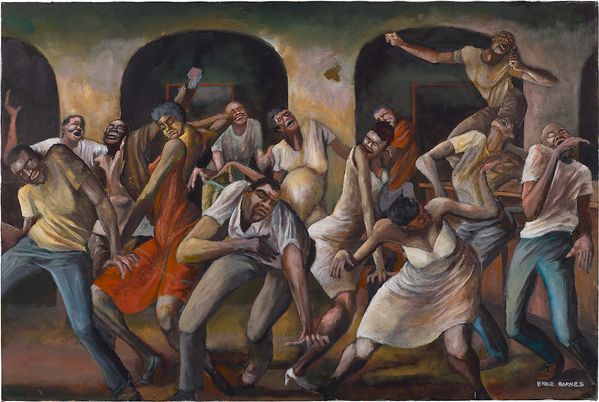
Ernie Barnes, Human Celebration, circa 1960s. Modern & Contemporary Art Day Sale, Morning Session.
In Human Celebration, circa 1960, Ernie Barnes presents a joyous dance scene, emblematic of the artist’s unique ability to conjure the rich emotional tapestry and intricate movement of the setting. One of Barnes’ most characteristic subjects, his depictions of dance halls were inspired by childhood memories of sneaking into a local Black dance club in the segregated North Carolina where he grew up. Whereas the above works directly reference iconic imagery from art history, Human Celebration sees the artist paint a scene directly tied to his personal history in a manner reminiscent of El Greco’s elongated and twisted human forms. Here, Barnes employs painterly skill that is on par with El Greco in an image that also suggests a parity of importance between 1960s American Black culture and historic European depictions of biblical scenes.

El Greco, Christ Cleaning the Temple, before 1570, National Gallery of Art, Washington, D.C. Image: National Gallery of Art, Washington, D.C., Samuel H. Kress Collection, 1957.14.4.
Much of Barnes’ personal story is intricately tied to American culture: he played five seasons in the American Football League before concentrating on painting from the mid 1960s and his 1976 painting of a dance hall scene, The Sugar Shack, was selected as the cover art for Marvin Gaye’s album I Want You and used in the end credits of the sitcom Good Times. His athletic background informed his practice in the intricate ways in which bodies mingle and intertwine in his dance hall scenes, and his personal experience of American settings from the football field to the pool hall lend a timeless cultural relevance to his imagery. His personal history meets his carefully studied approach to painting in works that sing with an individual voice that is enduring and recognizable.
Manolo Valdés
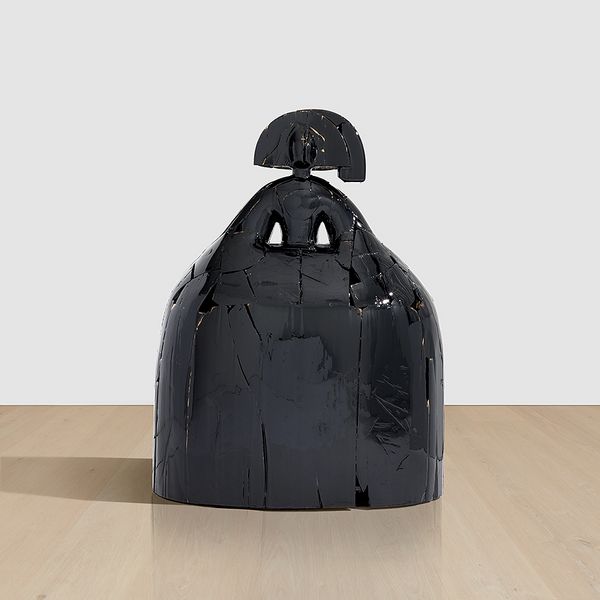
Manolo Valdés, Reina Mariana, 2016. Modern & Contemporary Art Day Sale, Morning Session.
Spanish artist Manolo Valdes employs references to historic works in a practice that engages humor, social and political commentary, and irony. A crucial figure in the development of the Spanish Pop Art movement, his works tend to focus on the collective identity of Spanish culture through its history. 2016’s Reina Mariana is directly referential to Velázquez’s portraits of Mariana of Austria, who was Queen of Spain from 1649–1655 through a tumultuous cultural and economic period known as the Spanish Decadence. By referencing this time, Valdes perhaps offers a reminder that this period in Spain was rich with art and culture, standing in contrast to the declining Spanish Monarchy.
The wood surface of the sculpture is painted with black epoxy, lending an industrial tangibility to the mythic figure of Spanish culture, and opposing the decadent ornamentation of Velazquez’s portraits of her. In this life-sized work, the Queen’s likeness appears almost embalmed, frozen in time, and becomes an irreverent icon that calls to mind the complexities of Spanish history. This form has been revisited by the artist for public projects throughout global cities, including in New York, Munich, Biarritz, Madrid, and concurrently, in St. Mark’s Square in Venice.

Diego Rodríguez de Silva y Velázquez, Queen Mariana of Austria, 1952–1653. Image: © Museo Nacional del Prado © Photo MNP / Scala, Florence.
Discover More

Julien Nguyen, Point Break, 2016. (Left). Dominic Chambers, After Albers (LA Sunset), 2020. (Right). Modern & Contemporary Art Day Sale, Afternoon Session.
There are further works across our Day Sales that explore references to historic images as well, but often for different reasons. The imagery of Julien Nguyen’s allegorical paintings reference art history, science fiction, and contemporary life in works that are lucid yet complex. Dominic Chamber’s After Albers (LA Sunset) juxtaposes the recognizable geometric forms of Josef Albers with a focus on concerns around identity and leisure.
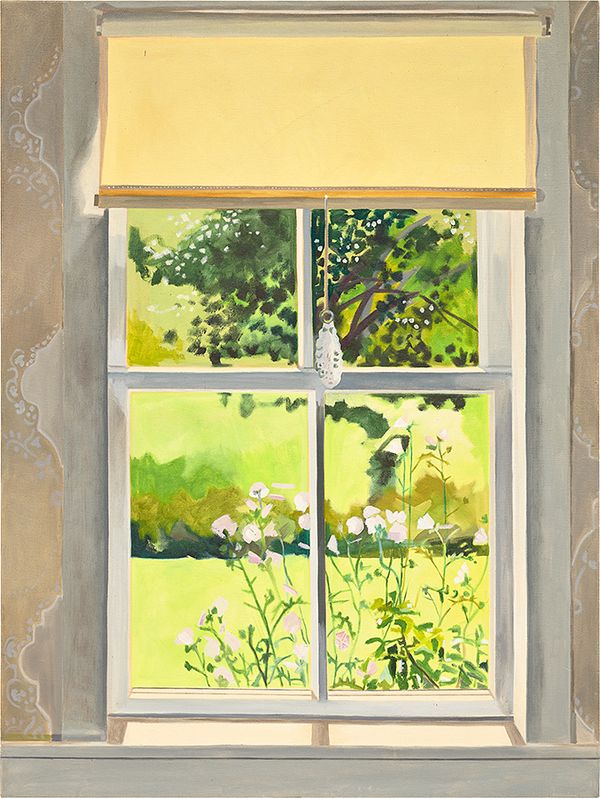
Lois Dodd, Wild Geraniums, 1974. Modern & Contemporary Art Day Sale, Morning Session.
Lois Dodd’s 1974 painting Wild Geraniums obliquely references a tradition began by Henri Matisse, showcasing the psychological ambiguity of windows and their ability to either let things in our shut them out. With artists routinely incorporating ideas absorbed from the study of historical works, the full selection on offer presents hidden surprises to the informed eye. What other references can you find?
Modern & Contemporary Art Day Sale, Morning Session >
Modern & Contemporary Art Day Sale, Afternoon Session >
Discover More from Modern & Contemporary Art >
Recommended Reading
The Phillips Guide to New York Art Week >
